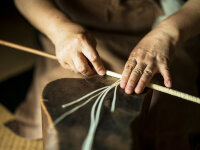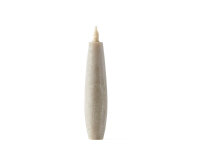
Japanese Candles
Japanese Candles (WA-ROUSOKU)
It is said that WA-ROUSOKU (Japanese candles) originated in Japan with the introduction of Buddhism. Originally, they are believed to trace back to an object from the Nara period (710-794 AD) made from beeswax collected from beehives. During the Edo period (1603-1868 AD), the cultivation of Haze trees, a raw material used for WA-ROUSOKU, flourished in Kyushu and Shikoku. This marked the beginning of their use among a broader population.
Due to Nanao's natural harbor, it flourished as a port of call for cargo ships traversing the Sea of Japan during this era. These ships brought the wax for WA-ROUSOKU from Kyushu and the WASHI (Japanese paper) for the wick from Iwami (Shimane Prefecture). After production in Nanao, the WA-ROUSOKU were transported back to various regions throughout Japan aboard cargo ships. A cooperative for candle production, ROUSOKU-ZA, was established in Nanao and continued until the middle of the Meiji era (1868-1912 AD). Today, TAKAZAWA Candle carries on this tradition.
Traditional Shapes and Forms of Takazawa Candles
WA-ROUSOKU candles come in two traditional shapes. The IKARI-GATA (anchor-shaped) candle widens both at the top and bottom and narrows in the middle. The other form, BOU-GATA (stick-shaped), has a cylindrical shape. The term IKARI-GATA is derived from the anchor of a ship, "IKARI" in Japanese. This unique shape has both scientific and aesthetic aspects. The upper part was designed to widen upwards to prevent the wax from dripping down the candle after lighting. Additionally, this design made the candle more pleasing to the eye, giving it its distinctive shape today.
In addition to these traditional forms, TAKAZAWA has developed its own unique shapes seen in the TOHAKU and NANAO series, inspired by the art and nature of the city of NANAO where the candles are crafted.
Special Features of Takazawa Candles
WA-ROUSOKU candles have two main features: the use of plant-based materials and a unique wick-making method.
For the candles, wax is obtained from plant-based materials, including the fruits of the HAZE tree (sumac), rice bran, rapeseed oil, and the fruits of the URUSHI tree.
The wick is made by wrapping dried material from a plant in the Juncaceae family known as "Lamp Wick" or rush grass into a cylindrical shape with Washi paper. This unique wick-making method allows air to flow from the bottom of the candle through the hollow center of the wick to the top, allowing the wick to absorb more melted wax, which, in turn, enhances the burning and provides a large, robust flame to the candle.
WA-ROUSOKU became popular among people with the spread of Buddhism, and within this historical context, these candles are frequently used as tools for prayer at religious sites. They are used, for instance, in temples, on BUTSUDAN (Buddhist altars) in homes, and at gravesites.
They also serve as a way to take time for oneself amidst the busy modern life. Candles can be lit to make time for meditation or yoga, both of which calm the body and mind, to relieve stress upon returning home from work, or to engage in pleasant conversations with family during dinner. Their use is a way to take time until the flame naturally extinguishes itself.




















